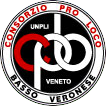GEOGRAPHY
Oppeano is 25 km south east of Verona, its surface is 46,82 km² and is located at an altitude of 26 m above sea level. Its fractions are: Ca’ degli Oppi, Vallese, Mazzantica and Villafontana shared with Bovolone and Isola della Scala. The rivers Bussè, Piganzio and Menago are the river Tartaro’s tributaries and flow through the town’s territory. It borders the comuni of San Giovanni Lupatoto, Zevio, Palù, Ronco all’Adige, Isola Rizza, Bovolone, Isola della Scala and Buttapietra.
ETYMOLOGY
The first written evidences quoting Oppeano date back to the ninth and tenth century, even if the name used was not always the same: “Opdanum”, “Oppidanum” and “Castropedanum” referencing the idea of a fortified burg. The name of its fraction Cadeglioppi comes from “Domus Oppiorum” meaning “casa dell’acero oppio” (“House of the maple”) a tree of the maple family. The area is indeed rich in field maples (called Oppi), oaks, hazelnut trees and elm trees.
HISTORY
The woods growing on the riverbanks helped the establishment of the first men, and several are the Bronze-Age remains of stilt houses that were scattered all over this swampy area. The ruins of a necropolis od 1300 b.C. are the evidence of the first inhabited centre. Much richer and relevant were the marks left by the Este culture. The objects found in the burial grounds around Oppeano are today exhibited in the museums of: Este, Verona, Oppeano and Legnago, in addition to Roma and Firenze where there is the famous “bronze helmet” of the second period of the Este culture. In 589, the breach at Cucca caused a shift in the Adige’s flow, which abandoned its former river bed. The floods forced the inhabitants to move on the new dry lands, which is where in the middle age “Castrum Euppedanum” was born, it was an entrenched camp that would later get reinforced and turned into a humble castle. Today, what remains of the fortification is only the stump of a tower, almost unrecognizable. After the defeat of Emperor Frederick Barbarossa, Verona became a free comune and included Oppeano and Mazzagatta, the current Mazzantica, in its jurisdiction. In 1100 a work plan to reclaim the marsh lands that went from Vallese to Ronco all’Adige was agreed upon. In 1230, on these lands the troops of Mantova were defeated by Ezzelino da Romano. Later, Oppeano was subjugated by the podestà of Verona and then by the Signoria Scaligera. With the fall of the latter and after some alternation of other noble houses, from 1405 to 1769 Oppeano remained under the domination of the Serenissima Repubblica di Venezia. During this age the remaining swamps were reclaimed and cleared in order to use them for rice farming and sericulture. Many important country manors were built, and so were rich noble abodes that today still appear on the local landscape. In the seventeenth and eighteenth centuries, in addition to poverty, plagues and banditry, the town suffered the ongoing wars. After the defeat of La Serenissima in the Napoleonic campaign in Italy, the French troops encamped in Vallese and Cadeglioppi. After the Congress of Vienna, Veneto became Austrian domain and faced harsh punishments for its participation in several revolts. Upon the end of the Austrian domination, Oppeano entered the Kingdom of Italy, and due to the severe political, social, health and economic problems its population was at times forced to emigrate. During the First World War there was an airstrip in Cadelglioppi, headquarters of the Corpo Areonautico Militare of the King’s Army.
ART
The parish of Mazzantica was built upon its former structure of the years 1000s and inside it, there are some paintings of the 1600s. In Bagnolo there is the Romanesque church of Sant’Antonio Abate, consecrated in the late 1300s, in its frescoed interiors there is a valuable small wooden crucified Christ. In the parish of Santa Maria Addolorata, built in the 800s and completely rebuilt in 1841 there is an exquisite altar of 1631 and an altarpiece by Felice Brusasorci, painter of the late 1500s, in addition to some interesting altarpieces by Pasquale Ottimo of the early 1600s, a “Vergine del Rosario” painting by an unknown author and a “Battesimo di Cristo” with the emblem of the Fracastoro family, who owned the homonymous palace. Several and once lavish Villas of the Venetian nobles are scattered across the territory, such as Villa Altichieri of the 1800s, with its liberty interiors; Villa and Corte Montara of the 1700s with its decorated façade; Villa Guarnieri in Vallese of the 1700s, recently restored and Villa Guasteverza Benciolini of the 1700s in Villafontana. Worth of mention are the following manors: Corte domenicale Fracastoro; Corte Baughi Peccana in Finiletto, recently restored; Corte Bongiovanni Mocenigo, with its sober looks of the late 1700s and the nearby rice mill of the 1739; Corte Turco of the 1700s with its baroque chapel, Corte Giona Carli in Trambellarè; Corte Farfusola in Cadelferro; Corte Nichesola in Cadeglioppi and finally Corte Rossa or Canossa. The town hall hosts the Museo della Cività Paleoveneta.
ECONOMY
The water composition, particularly rich, favours agriculture and focusses on plantations of grains, tobacco and fodder, but specialises in apple, pear, peach and red radicchio farming. Cattle, pig and bird farms constitute a productive branch. Industry, trade and craftsmanship experienced in the last 40 years a substantial growth.
